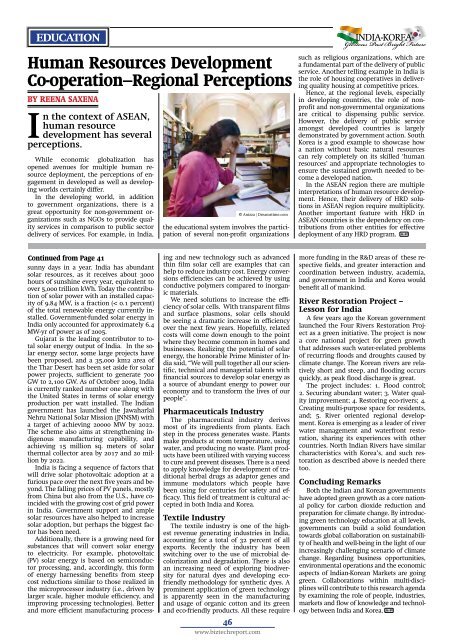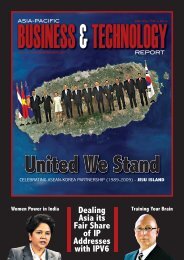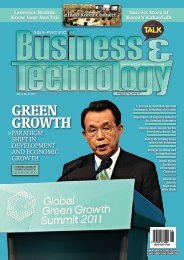INDIA-KOREA - Asia-Pacific Business and Technology Report
INDIA-KOREA - Asia-Pacific Business and Technology Report
INDIA-KOREA - Asia-Pacific Business and Technology Report
Create successful ePaper yourself
Turn your PDF publications into a flip-book with our unique Google optimized e-Paper software.
EDUCATION<br />
Human Resources Development<br />
Co-operation–Regional Perceptions<br />
by Reena Saxena<br />
In the context of ASEAN,<br />
human resource<br />
development has several<br />
perceptions.<br />
While economic globalization has<br />
opened avenues for multiple human resource<br />
deployment, the perceptions of engagement<br />
in developed as well as developing<br />
worlds certainly differ.<br />
In the developing world, in addition<br />
to government organizations, there is a<br />
great opportunity for non-government organizations<br />
such as NGOs to provide quality<br />
services in comparison to public sector<br />
delivery of services. For example, in India,<br />
© Anizza | Dreamstime.com<br />
the educational system involves the participation<br />
of several non-profit organizations<br />
<strong>INDIA</strong>-<strong>KOREA</strong><br />
Glorious Past Bright Future<br />
such as religious organizations, which are<br />
a fundamental part of the delivery of public<br />
service. Another telling example in India is<br />
the role of housing cooperatives in delivering<br />
quality housing at competitive prices.<br />
Hence, at the regional levels, especially<br />
in developing countries, the role of nonprofit<br />
<strong>and</strong> non-governmental organizations<br />
are critical to dispensing public service.<br />
However, the delivery of public service<br />
amongst developed countries is largely<br />
demonstrated by government action. South<br />
Korea is a good example to showcase how<br />
a nation without basic natural resources<br />
can rely completely on its skilled ‘human<br />
resources’ <strong>and</strong> appropriate technologies to<br />
ensure the sustained growth needed to become<br />
a developed nation.<br />
In the ASEAN region there are multiple<br />
interpretations of human resource development.<br />
Hence, their delivery of HRD solutions<br />
in ASEAN region require multiplicity.<br />
Another important feature with HRD in<br />
ASEAN countries is the dependency on contributions<br />
from other entities for effective<br />
deployment of any HRD program. A-P<br />
Continued from Page 41<br />
sunny days in a year. India has abundant<br />
solar resources, as it receives about 3000<br />
hours of sunshine every year, equivalent to<br />
over 5,000 trillion kWh. Today the contribution<br />
of solar power with an installed capacity<br />
of 9.84 MW, is a fraction (< 0.1 percent)<br />
of the total renewable energy currently installed.<br />
Government-funded solar energy in<br />
India only accounted for approximately 6.4<br />
MW-yr of power as of 2005.<br />
Gujarat is the leading contributor to total<br />
solar energy output of India. In the solar<br />
energy sector, some large projects have<br />
been proposed, <strong>and</strong> a 35,000 km2 area of<br />
the Thar Desert has been set aside for solar<br />
power projects, sufficient to generate 700<br />
GW to 2,100 GW. As of October 2009, India<br />
is currently ranked number one along with<br />
the United States in terms of solar energy<br />
production per watt installed. The Indian<br />
government has launched the Jawaharlal<br />
Nehru National Solar Mission (JNNSM) with<br />
a target of achieving 20000 MW by 2022.<br />
The scheme also aims at strengthening indigenous<br />
manufacturing capability, <strong>and</strong><br />
achieving 15 million sq. meters of solar<br />
thermal collector area by 2017 <strong>and</strong> 20 million<br />
by 2022.<br />
India is facing a sequence of factors that<br />
will drive solar photovoltaic adoption at a<br />
furious pace over the next five years <strong>and</strong> beyond.<br />
The falling prices of PV panels, mostly<br />
from China but also from the U.S., have coincided<br />
with the growing cost of grid power<br />
in India. Government support <strong>and</strong> ample<br />
solar resources have also helped to increase<br />
solar adoption, but perhaps the biggest factor<br />
has been need.<br />
Additionally, there is a growing need for<br />
substances that will convert solar energy<br />
to electricity. For example, photovoltaic<br />
(PV) solar energy is based on semiconductor<br />
processing, <strong>and</strong>, accordingly, this form<br />
of energy harnessing benefits from steep<br />
cost reductions similar to those realized in<br />
the microprocessor industry (i.e., driven by<br />
larger scale, higher module efficiency, <strong>and</strong><br />
improving processing technologies). Better<br />
<strong>and</strong> more efficient manufacturing processing<br />
<strong>and</strong> new technology such as advanced<br />
thin film solar cell are examples that can<br />
help to reduce industry cost. Energy conversions<br />
efficiencies can be achieved by using<br />
conductive polymers compared to inorganic<br />
materials.<br />
We need solutions to increase the efficiency<br />
of solar cells. With transparent films<br />
<strong>and</strong> surface plasmons, solar cells should<br />
be seeing a dramatic increase in efficiency<br />
over the next few years. Hopefully, related<br />
costs will come down enough to the point<br />
where they become common in homes <strong>and</strong><br />
businesses. Realizing the potential of solar<br />
energy, the honorable Prime Minister of India<br />
said, “We will pull together all our scientific,<br />
technical <strong>and</strong> managerial talents with<br />
financial sources to develop solar energy as<br />
a source of abundant energy to power our<br />
economy <strong>and</strong> to transform the lives of our<br />
people”.<br />
Pharmaceuticals Industry<br />
The pharmaceutical industry derives<br />
most of its ingredients from plants. Each<br />
step in the process generates waste. Plants<br />
make products at room temperature, using<br />
water, <strong>and</strong> producing no waste. Plant products<br />
have been utilized with varying success<br />
to cure <strong>and</strong> prevent diseases. There is a need<br />
to apply knowledge for development of traditional<br />
herbal drugs as adaptor genes <strong>and</strong><br />
immune modulators which people have<br />
been using for centuries for safety <strong>and</strong> efficacy.<br />
This field of treatment is cultural accepted<br />
in both India <strong>and</strong> Korea.<br />
Textile Industry<br />
The textile industry is one of the highest<br />
revenue generating industries in India,<br />
accounting for a total of 32 percent of all<br />
exports. Recently the industry has been<br />
switching over to the use of microbial decolorization<br />
<strong>and</strong> degradation. There is also<br />
an increasing need of exploring biodiversity<br />
for natural dyes <strong>and</strong> developing ecofriendly<br />
methodology for synthetic dyes. A<br />
prominent application of green technology<br />
is apparently seen in the manufacturing<br />
<strong>and</strong> usage of organic cotton <strong>and</strong> its green<br />
<strong>and</strong> eco-friendly products. All these require<br />
46<br />
www.biztechreport.com<br />
more funding in the R&D areas of these respective<br />
fields, <strong>and</strong> greater interaction <strong>and</strong><br />
coordination between industry, academia,<br />
<strong>and</strong> government in India <strong>and</strong> Korea would<br />
benefit all of mankind.<br />
River Restoration Project –<br />
Lesson for India<br />
A few years ago the Korean government<br />
launched the Four Rivers Restoration Project<br />
as a green initiative. The project is now<br />
a core national project for green growth<br />
that addresses such water-related problems<br />
of recurring floods <strong>and</strong> droughts caused by<br />
climate change. The Korean rivers are relatively<br />
short <strong>and</strong> steep, <strong>and</strong> flooding occurs<br />
quickly, as peak flood discharge is great.<br />
The project includes: 1. Flood control;<br />
2. Securing abundant water; 3. Water quality<br />
improvement; 4. Restoring eco-rivers; 4.<br />
Creating multi-purpose space for residents,<br />
<strong>and</strong>; 5. River oriented regional development.<br />
Korea is emerging as a leader of river<br />
water management <strong>and</strong> waterfront restoration,<br />
sharing its experiences with other<br />
countries. North Indian Rivers have similar<br />
characteristics with Korea’s, <strong>and</strong> such restoration<br />
as described above is needed there<br />
too.<br />
Concluding Remarks<br />
Both the Indian <strong>and</strong> Korean governments<br />
have adopted green growth as a core national<br />
policy for carbon dioxide reduction <strong>and</strong><br />
preparation for climate change. By introducing<br />
green technology education at all levels,<br />
governments can build a solid foundation<br />
towards global collaboration on sustainability<br />
of health <strong>and</strong> well-being in the light of our<br />
increasingly challenging scenario of climate<br />
change. Regarding business opportunities,<br />
environmental operations <strong>and</strong> the economic<br />
aspects of Indian-Korean Markets are going<br />
green. Collaborations within multi-disciplines<br />
will contribute to this research agenda<br />
by examining the role of people, industries,<br />
markets <strong>and</strong> flow of knowledge <strong>and</strong> technology<br />
between India <strong>and</strong> Korea. A-P









